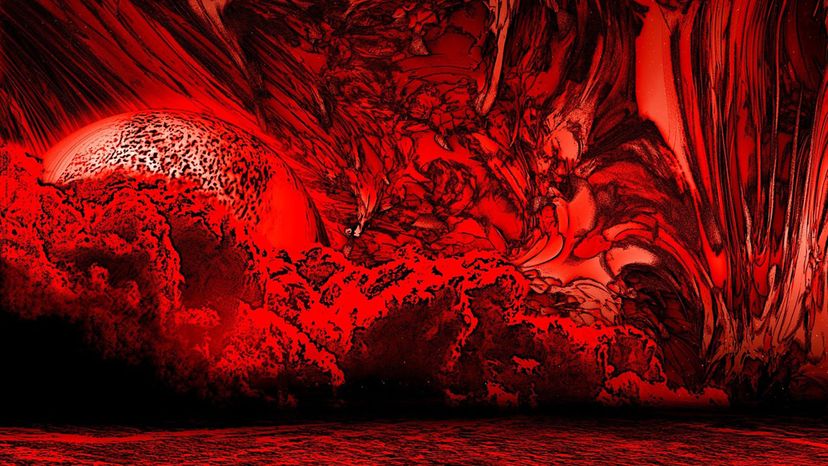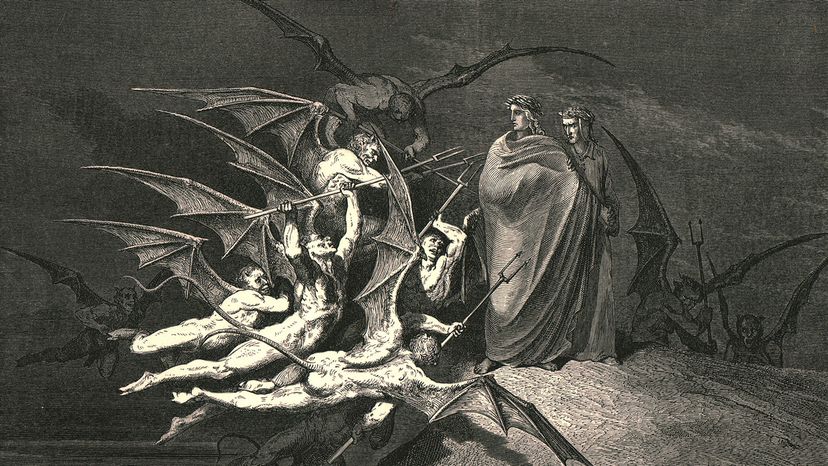Religion, Eternal Punishment, And Hell-Gehenna (With A Special Guest Appearance By Bertrand Russell)
Compendium Of Best "Pax" Posts Concerning The Damnation Of White, Conservative Christians (Assuming There Is A Hell, Which I Don't Believe)
"A Short History of Hell"
What do you believe about heaven and hell? Even if you're not religious, it's hard to escape the pull of these two opposing fates awaiting mankind after death: eternal paradise and joy in the clouds or eternal damnation and despair in the fiery depths.
The concept of hell is present in many religions ― such as the Mesopotamian religions from the third century B.C.E., as well as in Roman and Greek mythology (Hades, anyone?). Islam, Buddhism and Hinduism all acknowledge the existence of a hell, too. But for the purposes of this article, we'll concentrate on the Judeo-Christian concept of hell. Where did our collective Western image of hell come from? And has it always been the same since the very beginning?
Not at all, says Jeffrey Trumbower, a professor of religious studies at St. Michael's College in Burlington, Vermont and author of "Rescue for the Dead: The Posthumous Salvation of Non-Christians in Early Christianity."
"There's hardly any conception of the afterlife in the Hebrew Bible," says Trumbower, referring to the books that largely comprise the Old Testament in Christianity. Compared to the ancient Egyptians, whose 'Book of the Dead' and 'Book of Gates' present robust visions of what awaits us after death, the people of Palestine hardly gave it a thought.
In rare passages, the Hebrew Bible gives glimpses of Sheol, the Hebrew underworld, as a dull shadowy existence, a neutral storage place for all of the dead, both good and evil. In the book of 1 Samuel 28:7-24, for example, a troubled Saul wants to speak to the dead prophet Samuel, so he consults a witch or medium who can summon the dead.
"What does he look like?" [Saul] asked.
"An old man wearing a robe is coming up," she said.
Then Saul knew it was Samuel, and he bowed down and prostrated himself with his face to the ground.
Samuel said to Saul, "Why have you disturbed me by bringing me up?"
For Trumbower, it's striking that Samuel, "a great prophet and certainly a righteous person," was not living in some kind of heavenly paradise, but instead grumpily arose "out of the earth" as if he'd been awoken from a long nap. In the ancient Hebrew imagination, Sheol was a single dumping ground for all the world's dead.
So where do we first get the idea of divine judgment, of God separating the good from the evil and sentencing them to opposing fates? The earliest biblical mention is in the book of Daniel 12:2 written around 165 B.C.E., in which the prophet is given a vision of the Day of Judgment.
Rather than a neutral afterlife, Daniel gives us the first description of what historian Alan Bernstein calls "moral death," where your eternal fate depends on how you lived your life. Trumbower says that by the first century C.E., the idea of a final judgement where God metes out different rewards and punishments was widespread within Judaism.
"When you have the Jesus movement [Jews who decided to follow Jesus], they're already steeped in this kind of stuff," says Trumbower.
A New Kind of Hell
In the New Testament, Jesus and his disciples introduce a new term for hell, the Hebrew word Gehenna. According to Jewish tradition, Gehenna was a valley outside of the city walls of Jerusalem that doubled as a trash dump, where garbage was continually burned.
"It was a foul, dank, smelly place, so it became a word used for this hellish fiery pit where people are tormented," says Trumbower.
But when the New Testament talks about hell, it still mostly envisions hell as the place where evildoers are sent only after the Day of Judgment, not directly after death. Take the Gospel of Matthew, for example, in which Jesus shares the parable of the sheep and the goats, in which the "King" separates the good and the evil in the last days as a shepherd separates his sheep from the goats.
There is, however, one striking example in the gospels of hell as the place where the bad guys are sent right after they die to be tortured for their sins. It's the story of the rich man and the beggar Lazarus found in Chapter 16 of the Gospel of Luke.
In the tale, the rich man feasts while Lazarus subsists on the scraps that fall from his table, dogs licking his open sores. When both men die, Lazarus the beggar is "carried to Abraham's side" in heaven and the rich man is sent the opposite way.
"But Abraham replied, 'Son, remember that in your lifetime you received your good things, while Lazarus received bad things, but now he is comforted here and you are in agony.'"

The first real graphic descriptions of hell and its torments come outside of the New Testament canon in the Christian apocryphal texts of the second century C.E. One of the most colorful visions of hell is recorded in the Apocalypse of Peter, which was widely known in Christian circles at the time, though not considered part of the biblical canon.
After describing heaven as "exceeding bright with light... and the earth itself blooming with unfading flowers and full of spices and plants, fair-flowering and incorruptible and bearing blessed fruit," the author gets into the juicy stuff. Each punishment in hell is fitted to the crime.
Murderers were "cast into a certain strait place, full of evil snakes, and smitten by those beasts" while the souls of the murdered looked on with satisfaction. Those who blasphemed and slandered the righteous were forced to "[gnaw] their own lips... and [receive] a red-hot iron in their eyes." The rich who refused the orphans and widows were made to wear "tattered and filthy" garments and to walk endlessly over "pebbles sharper than swords or any spit, red-hot."
In modern times, many theologians have downplayed the images of horror and stressed that the worst part of hell is not the snakes and the fire (which are likely not literal) but rather, being separated from God.
And What About Satan?
Satan wasn't always a red demon with horns, cloven feet and a pitchfork. When we first meet him in the Old Testament Book of Job, he's presenting himself to God along with several "sons of God" and comes up with the idea of testing the faith of Job by stripping him of everything he possesses. To the ancient Hebrews, Satan was an adversary, tempter and an accuser of man, but not pure evil, says Trumbower.
That later view of Satan, he says, was probably borrowed from Zoroastrianism, the religion of Persia, which ruled over the Jewish people for 200 years from 530 to 330 B.C.E.

"The Persian religion was dualistic," says Trumbower, "with an ultimate good and an ultimate evil constantly at war. The Persians also believed in an 'end time' and a final conflagration."
By the time of Christ, Jesus' Jewish followers would have absorbed this Persian version of Satan as the source of all evil and the chief opposition of God. As for the horns and hooves, that imagery was likely borrowed from pagan gods like Moloch and Pan, and medieval authors like Dante gave Satan bat wings in his "Inferno" to contrast with the feathered wings of the angels.

No comments:
Post a Comment